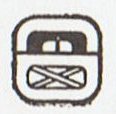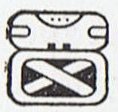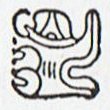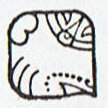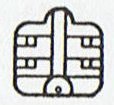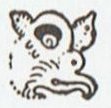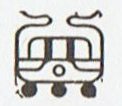7. There are 6 rising maro signs in line a3, and maybe there are 6 feather signs in front at Ga3-5 in order to make a total of 16 for the first 3 of them:
The front side of the year possibly was regarded as 160 days long:
Number 16 (twice 8) is also the ordinal number of the last glyph in the 3rd period:
It contains a week and ends with Jupiter. The π-glyph (haś) is at Mars and it has an adjunct in form of 3 toes who have come loose. They form the opposite of the 3 tiny feathers at the top end which also have come loose. The distance betweem them is not far and the meaning could be to indicate how the end of the top (the old curved generation) will continue as the beginning of the front bottom (new generation). The seeds of the old generation will sprout in spring. Counted from the beginning of the old generation Ga3-14 could be number 472 + 74 = 546 = 6 * 91 = 13 * 42. Compared with my haś prototype we can see several adjuncts:
The 20 days from haś in Ga2-23 implies great changes and once the following were my conclusions as I documented them in my preliminary dictionary: There is one more important haś glyph worth mentioning, viz. Ga2-23:
The number of feather marks are 4 (dots) + 2 (great) + 8 (normal) + 2 (dots) = 16. We should compare with Ga3-14:
Whereas in Ga3-14--15 there is a triplet of 'spookiness' (3 at the tip of the 'branch', 3 'toes', and the sign 3 at the top of the left part of Ga3-15), in Ga2-24--26 we can read the opposite - new life (new fire) formulated as triplets of fingers (thumbs not counted). There are more reversals. Reversal is also expressed in how the 4 spooky dot-like feathers in Ga2-23 have 'come down to earth' (are 'alive') in Ga3-14. The 2 great feathers following the 4 dots in Ga2-23 have, moreover, changed places in Ga3-14, where basically we have at first the 2 feathers meaning the 2 half-years and then the 4 feathers meaning the quarters. Ga3-14 probably describes the new year, while in Ga2-23 we see the 4 old quarters as 'spooky', no longer present with us (more than in our memory). I do not endorse all these remarks now, but the observation of how 4 'dots' which are followed by 2 'great feathers' in Ga2-23 changes to 2 'great feathers' followed by 4 'great feathers' in Ga3-14 is interesting because it suggests a point of turnaround between them. 4 'dots' (like feathers flowing down from Tagaroa in the sky but not yet having reached earth) are followed by 2 great feathers rooted in earth. ... Ta'aroa sat in his heaven above the earth and conjured forth gods with his words. When he shook off his red and yellow feathers they drifted down and became trees ... In Ga2-23 it presumably means the 2 halves of 'earth' (not of the year) are still lying ahead. In Ga3-14 they evidently have arrived. The 4 following great feathers could represent 4 'pillars' which define the 4 quarters of the season when Sun is present, pillars which are holding the sky roof high. It makes sense because then follows 4 smaller feathers which could indicate the time when Sun has disappeared, hidden by rain clouds, and the picture says it is high up.
Another 4 - normally sized - feathers completes the cycle, 8 + 4 = 12. There is a gap between the 2 basic feathers (halves of 'earth') and the 12 following feathers rooted in earth, therefore the 2 feathers at the beginning should not represent months.
|
|||||||||||||||||||||||||||||||||||||||||||||||||||||||||||||||||||||||||||||||||||||||||||||||||||||||||||||||||||







